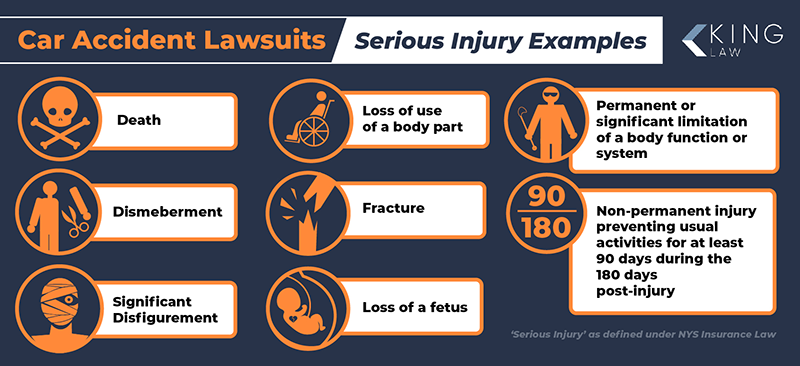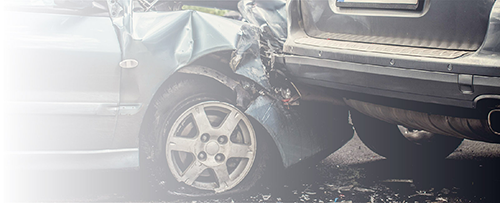
Table of Contents:
What Is a No-Fault State for Car Accidents?
Is New York a No-Fault State for Car Accidents?
The No-Fault Threshold in New York
Settlements for No-Fault Car Accidents in New York
What Happens When the Other Person Is at Fault
Compensation and Damages Outside of a No-Fault Accident
Types of Recoverable Damages Outside of a New York Car Accident
What Is a No-Fault State for Car Accidents?
In the United States, one dozen states have no-fault insurance laws, including New York. In these states, drivers must carry Personal Injury Protection (PIP) insurance that provides compensation for their injuries if they are hurt in a crash, regardless of who was at fault. Under limited circumstances, car accident victims can still sue an at-fault driver.
Under most circumstances, you will need to file a claim with your own insurance, provide a recorded statement, and undergo a medical exam by a licensed physician. If you are injured in a car accident in New York, it is imperative to speak to an attorney about your rights and responsibilities. An attorney can help you determine whether you should file a no-fault claim or pursue damages from another party.
Is New York a No-Fault State for Car Accidents?
New York is one of the twelve states that have a no-fault insurance system. Under New York’s no-fault insurance law, motorists are required to carry Personal Injury Protection (PIP) coverage. PIP coverage provides up to $50,000 to cover a person’s economic losses, including medical expenses, lost wages, and other accident-related costs regardless of who was at fault for the accident.
No-fault rules apply to passengers, pedestrians, and bicyclists who are involved in accidents with motor vehicles. The insurance policy covering the vehicle will pay for an injured party’s medical bills, lost wages, and other reasonable expenses, irrespective of fault. No-fault insurance does not cover the property damage to a person’s vehicle.
Liability Insurance Requirements in New York
New York law also requires individuals to carry liability insurance. Liability insurance protects you if a claim is made by another person that you caused an accident resulting in injuries.
Minimum Coverage Requirements for Liability Insurance in New York:
- $25,000/$50,000 for bodily injury per person
- $50,000/$100,000 for death
- $10,000 for property damage per accident
Unlike no-fault, liability insurance is designed to provide coverage for someone other than yourself who is injured or suffers property damage in an accident you cause. In order to obtain compensation through another driver’s liability policy, you must prove that the party was at least partially at fault for the car accident.
You may be able to obtain compensation for your pain and suffering if you sustained a “serious injury” as defined by New York law. However, under state law, motorcycle accidents are not subject to the “serious injury” threshold.
The No-Fault Threshold in New York
In order to file a personal injury lawsuit against an at-fault driver, you must either have basic economic losses that exceed $50,000 (the no-fault threshold) or have sustained a serious injury as defined by state law. Additionally, to file a claim based on pain and suffering, you must meet the no-fault threshold.
As defined by New York State Insurance Law § 5102(d), a serious injury includes:
- Death
- Dismemberment
- Fracture
- Loss of a fetus
- Permanent loss of use of a body part
- Permanent or significant limitation of a body function or system
- Significant disfigurement
- Non-permanent injury preventing usual activities for at least 90 days during the 180 days post-injury (90/180 day rule)
The 90/180-day rule allows for lawsuits when a non-permanent injury has impacted or limited your daily activities for 90 out of the 180 days since the accident. To prove this limitation, you must have objective medical evidence provided from an examination that occurred immediately after the accident.

Settlements for No-Fault Car Accidents in New York
While every accident is unique, settlement amounts are generally determined by several factors, including the seriousness of the injuries. If your injuries do not meet the serious injury threshold or your damages do not exceed $50,000, your settlement will be limited to basic no-fault benefits. Under some circumstances, you may be able to apply for Additional No-Fault or Additional PIP benefits to cover expenses that exceed $50,000.
How Liability is Determined in a New York Car Accident
Liability or fault in a New York car accident is usually based on a party’s negligence. You must prove that the other party was negligent in the operation of their vehicle, resulting in your injuries.
Negligence is proven by showing that the other party:
- Owed you a duty of care,
- Breached that duty of care,
- Their breach of the duty of care they owed you caused the accident and
- Your injuries were caused by the accident.
In general, all motorists have a duty of care to others on the road. Any traffic violation, such as speeding, driving under the influence, or texting while driving, may be considered a breach of that duty.
In order to prove that the other party breached their duty of care and the severity of your injuries, however, you will need to collect evidence. It is imperative to not only seek medical attention after an accident but also to speak to an attorney as soon as possible to determine your legal options.

What Happens When the Other Person Is at Fault?
Proving liability is key if another party is at fault for the accident. Liable parties may include other drivers, passengers, and auto manufacturers if a defective auto part was responsible for the accident.
Because New York is a no-fault insurance state, you will need to show that your basic economic losses exceed the $50,000 threshold or that you sustained a serious injury. Serious injuries may include any medically validated physical harm that hinders you from performing your normal activities for at least three months after the accident.
If you were partially to blame for the accident, you may still be entitled to obtain compensation. Your compensation, however, may be reduced in proportion to your portion of fault.
What If No One Admits Fault?
If liability is disputed or no one admits fault, it is essential to consult with an attorney. An attorney can help conduct an in-depth investigation to help determine who or what caused the accident. There may be one or more parties to blame for the crash, including yourself.
Cases where fault is disputed rely heavily on evidence. An attorney can help you collect evidence that may be necessary to prove your claim.
Compensation and Damages Outside of a No-Fault Insurance Accident
If you suffer a serious injury or have losses that exceed the $50,000 no-fault threshold, you may be able to file a lawsuit against a liable party. Depending on the circumstances, you may be eligible to file a fault-based claim against the negligent party’s insurance for serious and disabling injuries.
Fault-based claims may result in compensation for medical expenses, lost income, and related expenses. Unlike no-fault insurance claims, you may also be able to secure compensation to repair or replace your vehicle.
Dealing with another party’s insurance company, however, may prove challenging. Insurance companies frequently deny claims or offer inadequate compensation. Working with an attorney throughout the process can help ensure you receive the compensation you deserve.
Types of Recoverable Damages Following a New York Car Accident
There are four types of recoverable damages in New York car accident cases. The facts of your case will determine which types of recoverable damage you are eligible for after an accident with injuries.
Different types of recoverable damage available following a New York car accident:
- Compensatory damages: Compensatory damages cover financial losses that are incurred or expected as a result of your injuries.
- Punitive damages: Punitive damages are used as a deterrent. They are aimed at punishing the liable party.
- Nominal damages: Nominal damages compensate for emotional distress in the absence of physical injury.
- Comparative fault recoveries: Recovery for comparative fault applies if you are partially at fault for the accident. The damage award is reduced by your percentage of responsibility (fault) for the accident.
Working with an attorney can help ensure you receive the damages you are entitled to after an accident.
New York Car Accident Lawyers
If you were injured in an accident, contact King Law to speak with a New York car accident lawyer. Our lawyers will work with you to determine if you should file a claim for no-fault benefits or pursue a personal injury lawsuit due to your serious injuries.

